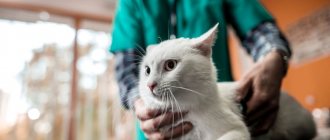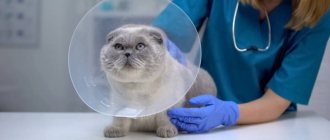Cancers in cats are quite rare. It is very important to undergo various tests periodically. This will help prevent the disease and possibly slow down its development, thereby extending the life of your four-legged friend. And if tests confirm that cats or cats have cancer, then don’t be upset. No one promises that the fight against such a terrible disease will be easy. However, it is with your help that the animal will live a long and happy life. Properly selected treatment will help the fluffy live for a very long time, delighting you with his presence.
What is cancer?
This disease is a disruption of the normal functioning of DNA molecules. These molecules are present in every cell of the body and are responsible for storing information about all procedures performed by each cell. Cancer begins with a small number of cells whose DNA molecules have gone wrong. They begin to divide uncontrollably and change their functions. These cells spread throughout the body through the bloodstream. New formations are localized at the places where they stop.
It should be noted that benign tumors do not spread metastases. Malignant formations, increasing in size, penetrate the tissues of healthy organs, preventing the normal performance of their functions. At the final stage of the disease, the body and immune system are simply unable to cope with the pathogenic effects of mutated cells.
Almost any tumor has its own lifespan, after which the process of decomposition begins, which provokes tissue necrosis, the appearance of ulcers and internal bleeding.
What are the predisposing factors of the disease?
In most cases, it is impossible to accurately answer the question: “Why did the cat get cancer?” However, there are many predisposing factors that lead to cancer:
- poor immune system;
- genetic predisposition;
- regular poor quality nutrition;
- microtrauma of internal organs;
- passive smoking (tobacco smoke is very harmful to the body of cats);
- insufficient physical activity and poor lifestyle in general;
- hormonal disbalance;
- constant stress;
- bacterial, fungal and viral infections;
- ionizing radiation;
- polluted ecology.
Is cat cancer contagious?
Recently, information has appeared on the Internet about the allegedly viral nature of this disease. In fact, such statements have no basis. Cancer is not contagious even if the affected cells are introduced into a healthy body. Numerous experiments on volunteers conducted by scientists around the world have never led to infection of the test subject.
At its core, cat cancer is identical to the disease that affects humans. So don’t believe empty talk that a pet with cancer can be dangerous for you and your family members.
Clinical picture and diagnosis
Alas, signs of cancer in a cat are rarely at least somewhat characteristic. As a rule, everything starts out quite harmlessly:
- The animal begins to get tired quickly, trying to spend more time huddled in some far corner. There are no external signs of anything wrong. Despite a certain weakness, the cat feels well, his appetite is not impaired, and his thirst also remains normal.
- Gradually, weakness becomes more noticeable, the animal loses its appetite. Sometimes the latter remains normal (up to a certain point), but exhaustion begins to progress.
- In some cases (tumors in the oral cavity, testicular lesions, etc.), neoplasms can be noticed visually. As a rule, at first, when palpating them, the pet does not show much concern, but soon they become extremely painful.
- Other symptoms largely depend on the location of the tumor. Thus, when the brain is damaged, seizures, changes in behavior are characteristic, sudden death or spontaneous falling into a coma is possible.
Diagnostics is not a simple matter. Firstly, as mentioned above, some types of tumors can be seen with the naked eye, but this is still rare. So they often resort to a full range of diagnostic measures, including radiography and ultrasound . Please note that not all types of cancer are clearly visible on x-rays. To improve their visual visibility, the use of contrast radiography is indicated.
In especially doubtful and complex cases, it is necessary to resort to diagnostic operations . They are also necessary in situations where it is not possible to take a sample of the tumor in any other way (i.e., do a biopsy). The latter, by the way, is always done in all cases when there is a suspicion of cancer. It is quite possible that the swelling on the cat’s head is just a benign lipoma; there is no reason to panic. On the contrary, a biopsy will help save the life of a cat whose skin has suddenly developed a strange birthmark (this is how the onset of many melanocarcinomas is characterized).
In recent years, marker-based cancer detection methods have become increasingly promising. They are based on identifying specific antibodies in the blood of an animal (and a person, by the way). The advantages of the method include high speed of diagnosis and quite adequate cost of the study. The disadvantage is that not all types of cancer in cats have a “dossier”, and not all tumors cause the formation of truly specific antibodies.
What does cancer look like in cats?
Manifestations of cancer are as follows:
- "Bumps" on the animal's body. Of course, it's not necessarily cancer, but it's worth checking out. Because they don’t just appear, any lump on a cat’s body must have an explanation.
- Neoplasms. Wounds that do not heal for a long time, sometimes with purulent discharge from them.
- Unexplained discharge of pus from any part of the animal's body.
- Bad breath.
- Change in animal behavior towards weakness and drowsiness.
- Sudden loss of body weight.
- Intermittent claudication.
- Dyspeptic disorders.
- Spots on the skin are red or have dry scales.
- Refusal to eat or eats, but very little.
- Problems with the respiratory system, genitourinary, digestive.
Sources
- De Martel C., Ferlay J., Franceschi S., Vignat J., Bray F., Forman D., Plummer M. Global burden of cancers attributable to infections: a review and synthetic analysis. The Lancet. Oncology. June 2012, 13 (6): 607–15.
- De Paoli P., Carbone A. Carcinogenic viruses and solid cancers without sufficient evidence of causal association. International Journal of Cancer. October 2013, 133(7): 1517–29.
- Mager DL Bacteria and cancer: cause, coincidence or cure? A review. Journal of Translational Medicine. December 2006, 4 (1): 14.
- Pagano JS, Blaser M., Buendia MA, Damania B., Khalili K., Raab-Traub N., Roizman B. Infectious agents and cancer: criteria for a causal relation. Seminars in Cancer Biology. December 2004, 14 (6): 453–71.
- Samaras V., Rafailidis PI, Mourtzoukou EG, Peppas G., Falagas ME Chronic bacterial and parasitic infections and cancer: a review. Journal of Infection in Developing Countries. June 2010, 4 (5): 267–81.
- Stewart BW, Wild CP Cancer etiology. World Cancer Report 2014. World Health Organization. 2014, pp. 16–54.
- Wu S., Powers S., Zhu W., et al. Substantial contribution of extrinsic risk factors to cancer development. Nature. 2016. Vol. 529, no. 7584. P. 43−47.
- Kiselev F.L., Imyanitov E.N., Kiselyova N.P. Molecular oncology. From viral theory to cancer treatment. Moscow: GEOS, 2013, 151 p.
Types of oncology in cats and its symptoms
Oncology is a disease in which cells begin to grow and expand into surrounding tissues completely uncontrollably. There are two types of malignant tumors: localized (when the tumor is limited to one affected area) and generalized (spread throughout the body).
The following cancers occur in cats:
Mammary cancer (breast in an animal)
Breast cancer (in first place in terms of prevalence). It affects unsterilized cats, and is more often observed in pets that have never given birth.
Tumors or lumps grow inside the mammary glands (breasts). First, small dense balls appear, which gradually increase in size and at the last stage open. If left untreated, the animal will not live long.
Lymphoma
The abnormal cells affect the lymph nodes, first one, and then spread to the others and affect the liver and bone marrow. The disease manifests itself as compaction of the affected lymph nodes.
Sarcoma (fibrosarcoma, osteosarcoma, liposarcoma)
This type of cancer is the most aggressive, as it spreads throughout the body very quickly. May occur in the abdominal cavity of cats. Manifested by lameness, apathy, emaciation. The animal is in severe pain and is worried.
Carcinoma and adenocarcinoma
This tumor affects the epithelial cells of internal organs and skin. It metastasizes very quickly. It can manifest itself as the formation of ulcers on the skin, damage to the gums and oral mucosa. The wound may open. If the lungs are affected, the cat may cough and pant. When the intestines are damaged, constipation, abdominal enlargement, and vomiting are observed.
- Why does a cat need a mustache?
- Rescue dogs
- Hypoallergenic cats
- Why does a cat need a tail?
- Chinchilla
- Dog breeds
Squamous cell carcinoma
This type of cancer affects the cat’s oral cavity and can affect the tongue, palate, and tonsils. In this case, non-healing ulcers form on the mucous membrane, and a strong and unpleasant odor appears. As the disease progresses, your pet may lose teeth and become crooked.
Almost all types of oncology are accompanied by such general symptoms as significant weight loss, apathy, and enlarged lymph nodes.
For owners about animal oncology
The main condition for the effectiveness of treatment of any disease is early diagnosis, but the importance of this situation in oncology should be especially emphasized.
In the late stage, cure of a malignant tumor is a rare exception. Among the causes of overall mortality in dogs and cats, tumor diseases confidently hold second place. The 1st and 2nd are occupied by tumors of the skin and mammary glands, respectively. Considering the high frequency of detection of cancer in pets, both doctors and animal owners should be alert to cancer.
When a pet owner asks a doctor what caused his pet's cancer, most often the question is abstract. He has no intention of learning about histones, DNA methylation, and stage 3 carcinogenesis. In fact, the owner means: why is my animal sick; you can cure it; What is the prognosis for each treatment method?
Our task is to make this mystery understandable.
Why is my animal sick?
Normal (healthy) cells have self-regulation. Abnormal (diseased) cells activate the p53 suppressor gene, which delays cell division until the abnormalities are corrected. If correction does not occur, p53 causes programmed cell death - apoptosis.
Cancer cells carry mutations and errors in genes, including the p53 gene. They avoid apoptosis and thus acquire “immortality.” After degeneration, unregulated rapidly dividing cancer cells are characterized by a gradual change in genotype.
Genetic failures can be spontaneous or can be caused by viruses, chemicals, parasites, radioactive radiation, occur under the influence of light rays, as a result of disruption of endocrine/metabolic processes and other mechanisms.
So, a tumor is a group of cells characterized by continuous growth and reproduction, uncontrolled by the body. Immortality, constant division, and gene dysregulation provide cancer cells with advantages that benign cells do not have.
Benign tumors, unlike malignant ones, do not penetrate beyond the tissues in which they began to develop or into other parts of the body. In most cases, the prognosis for benign tumors is favorable. However, they can have serious consequences if, for example, they compress vital structures such as blood vessels and nerves.
Malignant tumors are characterized by local growth into surrounding tissues and a high growth rate, so they reappear (recur) after surgical removal. Cancer cells are capable of metastasizing. Metastasis is the process of spread of tumor cells through the intercellular spaces into the bloodstream and lymph, allowing the emergence of new foci of tumor growth in various parts of the body.
Depending on the time of appearance and place of development, early and late, regional and distant metastases are distinguished. The earlier metastases appear, the more malignant the tumor. Distant metastases (not regional lymph nodes, organs) are a factor of unfavorable prognosis.
It is important to note that tumors that develop as benign can become malignant over time. Also, there is a certain group of diseases that have a high risk of becoming a malignant tumor: chronic gastritis, long-term non-healing ulcers of the mucous membranes and skin, glandular degeneration of the endometrium of the uterus, adenofibrous mastopathy, accompanied by a sharp proliferation of the epithelium, etc.
Stage of cancer
The pathological malignant process has a staged development; in total there are 4 phases:
- The first, initial, is accompanied by the appearance of a limited tumor nodule; there are no metastases.
- In the second stage, growth continues, the size of the formation increases to 6 cm, it grows deep into the organ and metastasizes to the nearest lymph nodes.
- The third stage is characterized by a decrease in tumor mobility and the appearance of increasingly large metastases throughout the body.
- The fourth stage is the most severe and hopeless, the tumor process affects larger and larger areas, ending in the death of the animal.
Causes of cancer in cats
As in human medicine, the causes of cancer in any given cat are often unknown, especially since many types of cancer can develop for a variety of reasons.
A congenital (genetic) predisposition to the formation of certain types of tumors in cats is considered almost certainly proven, although at present relatively little is known about the mechanism of transmission of this predisposition. Over the course of its life, a cat can interact with a variety of substances and encounter situations that have the potential to trigger abnormal cellular processes that ultimately lead to the development of cancer - this could even include exposure to sunlight, not to mention a wide range of chemicals (carcinogens). ) surrounding a cat in modern conditions. In most cases, the causes of cancer remain unknown.
It has been established that certain viral infections can cause cancer in cats, and feline leukemia virus is probably the best example of this. The virus infects the hematopoietic cells in the cat's bone marrow, which can lead to the development of leukemia and lymphoma. Fortunately, in most countries, infection with this virus is quite rare, and the virus is quite easily detected using simple tests.
Research shows that cats infected with feline leukemia virus are 50 times more likely to develop lymphoma compared to uninfected cats. In cats infected with feline immunodeficiency virus, the risk increases approximately 5 times.
When a cat is diagnosed with Cancer, owners usually ask, “What did I do wrong?” or “What should I have done to prevent this from happening?” While this is a very natural reaction to being told that a cat has cancer, it is important to understand that in the vast majority of cases, what led to the development of cancer remains unknown and therefore could not have been prevented.
Causes and individual susceptibility
The main cause of oncology is DNA damaged by carcinogens . The factors that provoke the appearance of cancer have not yet been fully determined. However, experts have identified several reasons that contribute to the development of a tumor in a cat.
Heredity
- Hereditary predisposition. The risk of getting sick increases significantly in animals whose family has had cancer for several generations.
- Weakened immunity. The protective function of the body is reduced due to poor ecology, improper feeding, previous diseases, and a sedentary lifestyle.
- Injuries to internal organs , as well as fractures and bruises can cause a tumor.
- Low-quality feed, saturated with chemicals and preservatives, increases the likelihood of developing cancer.
- Frequent or prolonged stress significantly worsens the pet’s condition and contributes to the development of many serious diseases, including cancer.
- Malfunctions of the hormonal system. Most often, this factor manifests itself in unsterilized animals, whose owners, instead of surgery, resort to hormonal drugs to reduce sexual desire.
- Prolonged exposure to the sun. Prolonged exposure to ultraviolet light can cause skin cancer.
- Chronically inhaling tobacco smoke significantly increases the risk of developing lung cancer.
The development of cancer does not depend on the breed or age of the pet. The disease can strike a kitten, a healthy young cat, or an older animal. But still, cancer is more often diagnosed in animals older than five years, and the peak incidence occurs at 10–12 years of age. Among cats over 12 years old, the percentage of cases decreases.
Symptoms of cancer in cats
Since cancer can affect any tissue in a cat's body, the clinical signs of its development are extremely varied. In addition, there are no signs that automatically confirm that the cause of their manifestation is cancer.
Older cats are mostly susceptible to cancer, and they develop it much more often than younger ones. In many cases, cancer develops over a fairly long period of time, initially manifesting itself in the form of vague signs of the disease, such as loss of appetite, loss of energy and weight loss. In some cases, there may be more obvious signs, such as persistent lumps in (or on) the skin, changes in the eyes, nausea, diarrhea, unexplained bleeding, or wounds that won't heal.
As the disease progresses, additional complications typically develop, usually related to the affected tissues and organs. Although cancer may be just one potential cause of various clinical signs (especially in older cats), it is important to understand that many diseases have the same symptoms as cancer. Even in cases where cancer is confirmed, there may be treatment options that can slow or delay the progression of the disease, at least for a period of time. However, it is important to diagnose cancer as early as possible so that treatment can begin on time.
Methods for diagnosing cancer diseases
Diagnosis of cancer is carried out according to the following algorithm:
- First, blood and urine are taken from the animal. Using tests, the functioning of internal organs is assessed.
- X-ray. This type of examination allows you to detect metastases that have spread throughout the body. For breast cancer, an X-ray is called a mammogram.
- Ultrasonography. In this way, tumors that are located shallowly can be detected. A biopsy is also performed using ultrasound.
- Biopsy. It is carried out in three ways: using a puncture, an endoscope and surgically. In the first case, tumor particles are taken with a special needle (the material is drawn into a sterile syringe) or an endoscope (a few affected cells are pinched off). In the third method, biomaterial is collected during surgery, and the surgeon can completely remove the tumor or take only a small piece of tissue for examination.
How to warn?
Bone or stomach cancer can be avoided if you constantly monitor your cat's health and regularly check it with a veterinarian. It is advised to vaccinate on time and avoid contact with sick street cats, from which the infection is transmitted. To prevent the appearance of skin cancer, it is recommended to limit the animal’s exposure to the sun. To prevent the appearance of mammary gland pathology, it is worth sterilizing the cat before the start of estrus. If diagnosis and therapy were carried out on time, then the cat can live a long and happy life.
Treatment
Cancer is one of the diseases that does not tolerate self-medication or the use of traditional medicine. Therapy largely depends on the type of formation, and on the stage of development - on how advanced the process is. To stop the proliferation of malignant cells in the initial stages of the disease, surgical intervention with complete excision of pathological tissue may immediately be required, and sometimes pharmacocorrection, chemotherapy, radiation also help - everything is very individual.
It is especially difficult to choose a treatment regimen at the last stage of the disease, when the animal is quite weak and is on the verge between life and death. The owners' demand to remove the tumor is not always justified, and the main goal of the veterinary specialist is no longer to cure the animal, but to alleviate its general condition so that the cat does not suffer or suffer. Sometimes in such situations it is necessary to take extreme measures, euthanizing the animal, giving it the opportunity to be freed from suffering.
In any case, you need to understand: cancer is not a death sentence, and miracles happen. In addition, the diagnosis made is not always correct: if there is no confidence in the competence of this veterinarian, no one forbids going to another and rechecking the results.
General information about radiotherapy
Under what conditions is the use of radiotherapy indicated? As a rule, it is prescribed not as a single “panacea”, but as a combination treatment, together with chemotherapy, and also before or after surgery. As a rule, this method of treatment is relevant in the case of “stationary” tumors that do not show a tendency to develop metastases. In addition, sometimes radiotherapy increases the life expectancy of a hopelessly ill animal (by slowing down the growth rate of the tumor). In this case, the pain is reduced, the incidence of bleeding becomes less frequent, etc.
Finally, regardless of the primary cancer management strategy chosen by your veterinarian, supportive care . In particular, drugs to maintain pulmonary and cardiac activity, drugs that relieve the effects of shock and stop the inflammatory process are vital (in the latter case, Dexamethasone is ideal).
Moreover, a cat whose body has a tumor should be protected in every possible way from pathogenic and conditionally pathogenic microflora. His immunity is already suffering greatly, and therefore the pet’s body will no longer survive the development of infectious pathology. Because of this, the animal has to be prescribed broad-spectrum antibiotics.
Disease Prevention
There are several effective preventive measures that will protect your pet from developing cancer:
- Sterilization . This measure will protect the cat from developing mammary cancer almost 100%, and it is advisable to carry out the operation either before the first heat or immediately after it.
- Isolate chemicals from your pet . There is an opinion that the development of oncology can be caused by prolonged exposure to chemicals on a cat. Therefore, it is necessary to keep fertilizers, detergents and other substances out of reach of the animal.
- Regular vaccination . This procedure will protect your pet from such serious illnesses as the immunodeficiency virus and coronavirus infection.
- Balanced diet . It is very important to pay attention to the preparation of your pet’s diet. It is better to give preference to industrial feed of at least super-premium class. Such nutrition will protect the cat from developing pathologies such as diabetes, obesity, etc.
- Removal from breeding of animals whose ancestors suffered from oncology . There is an opinion that a predisposition to cancer is inherited, so you should not get offspring from cats that have had sick pets in their family.
In the early stages, this disease can be treated, but for this it is necessary to contact a veterinarian at the first signs of cancer. If your pet begins to lose weight, refuses to eat, has a fever, or is limping, immediately take your pet to a doctor.
If the veterinarian has diagnosed late-stage cancer, you need to assess the cat's quality of life and consider humane euthanasia if she is in severe pain.
Video
Before starting treatment...
There are three “commandments” regarding the treatment of cancer in cats, the provisions of which must be observed by both veterinarians and direct animal owners.
Compliance with these rules is the key to success in eliminating cancerous tumors in animals.
First rule
Severe pain is bad. Numerous studies by both doctors and veterinarians have long proven that a strong pain reaction is the first thing you should pay attention to when treating cancer. The stronger the pain, the less effective the therapy becomes, the worse the medications work. It is necessary not only to anesthetize and muffle unpleasant sensations, but to stop them completely (but this is often still impossible). Local anesthesia helps only in some cases. Recently, in particular, the use of patches impregnated with anesthetic solutions has been recommended: slowly releasing, the latter provide uniform, constant pain relief. In mild cases, oral medications are also indicated.
Proper care of the animal also helps with pain management. Try to minimize the level of stress, do not “provoke” your pet into active games, even if it seems to you that he is feeling better. Active movements in this state can provoke a worsening of the disease. If the animal cannot move, use special orthopedic bedding (sold in specialized stores). Yes, it’s impossible to call such devices “affordable,” but they reduce the likelihood of bedsores by at least 70% and greatly simplify caring for a sick pet.
Second rule
Vomiting is a common but not normal consequence of chemotherapy and must be dealt with. Moreover, modern chemotherapy drugs do not involve the development of vomiting (as a rule). The problem is that with semi-digested masses, the animal’s body loses not only nutrients, but also water and electrolytes, which has the most detrimental effect on their health. In addition, when vomiting, pets begin to eat very poorly, and this also does not contribute to their recovery.
Third rule
Don't let a sick cat go hungry. This is perhaps the most important of all the rules we have voiced. Even if the animal does not eat, it must be force-fed. A good solution is a gastric tube, through which semi-liquid nutritional mixtures are introduced into the cat’s digestive tract. They will not only prevent your pet from dying of hunger, but will also contribute to the normal peristaltic activity of his intestines. But still, full treatment involves improving appetite. To do this, you can slightly heat the food: being warm, it emits more odors, attracting the cat. In some cases, it is recommended to provide special commercial food: its taste and smell are specially selected so that even a “half-dead” cat has an appetite. Of course, when eating, stress should be completely eliminated: a sick or recovering pet can eat only in a quiet, secluded place. Again, appetite stimulating medications are often used. Diazepam (Valium) and cyproheptadine are good for this role.
But still, in many situations, the animal’s condition can be very sad; it cannot eat on its own. And, as we have already said, there is only one way out - a gastric tube. There are several options for its use. In the best case for the pet, the device is occasionally inserted directly into the esophagus, feeding the “sad” cat. In the worst case, the probe is surgically implanted directly into the esophagus, the end is brought out onto the skin of the neck. Nutrient mixtures are injected there twice a day.
Food for the animal must be selected individually. A proper diet is not only the key to maintaining a normal weight , but also a guarantee of mitigating the side effects that inevitably occur in response to chemotherapy and radiotherapy.
Here are the basic rules to follow when preparing your diet:
- If possible, limit the amount of “fast” carbohydrates in the diet of a sick cat. The results of numerous studies indicate that such nutrition contributes to the accelerated development of cancer pathologies. This is especially important if your cat has the last stage of cancer. The more “fast” carbohydrates in food, the faster the disease will kill him.
- The daily diet should be designed to contain a sufficient amount of essential amino acids, that is, glutamine, cysteine and arginine.
- The food must contain a source of polyunsaturated Omega-3 fatty acids. A good option is cod liver or simple fish oil.
- It is recommended to add the second fraction of ASD to food (one drop per day). The product not only stimulates appetite, but also helps strengthen the animal’s immunity.
Drug therapy is only part of the measures taken to defeat animal cancer.
The owner needs to remember that the animal needs to ensure a good quality of life, since otherwise recovery may not occur...










